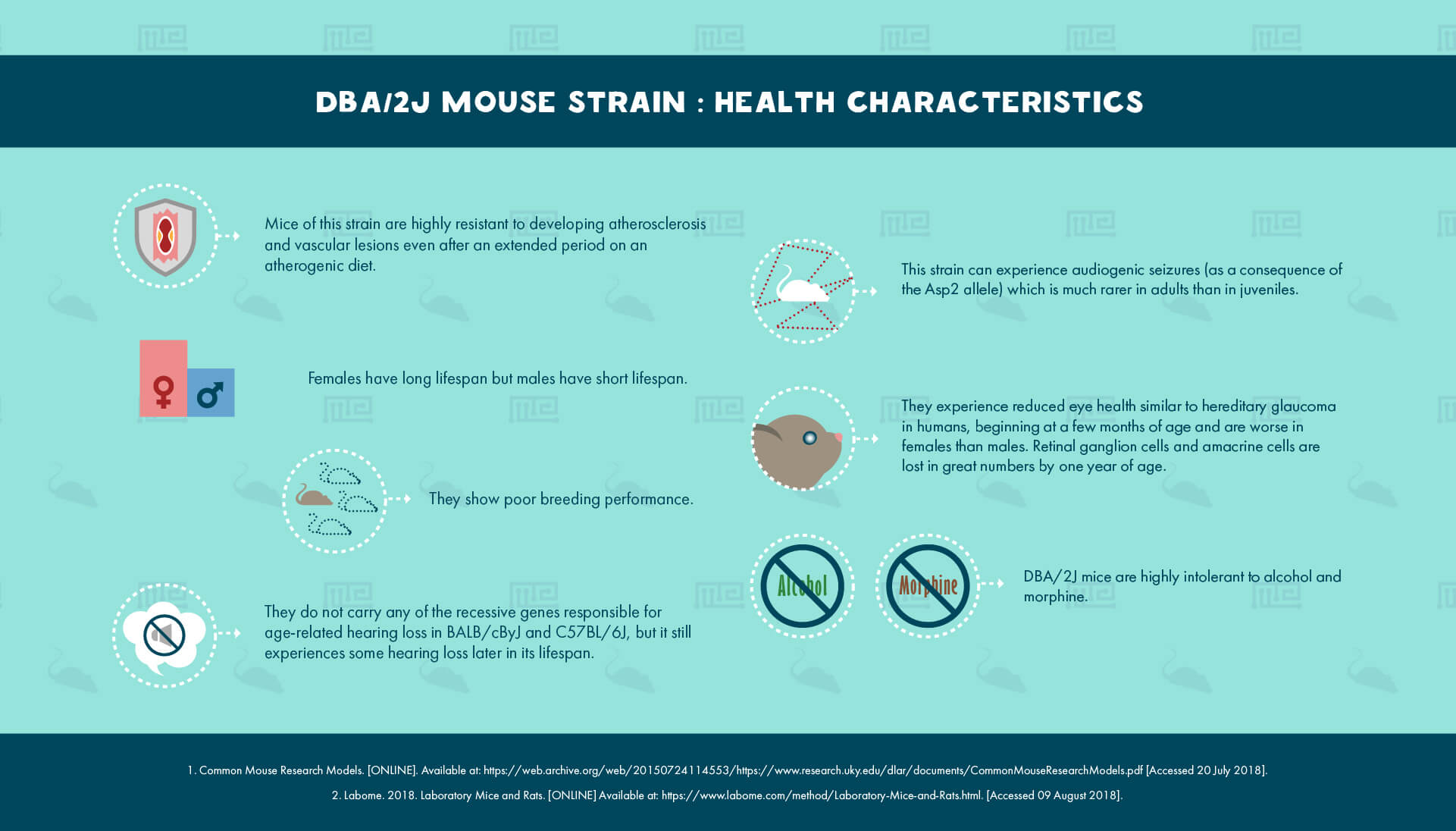Overview
The DBA/2J mouse strain is a very commonly used inbred strain. It often serves in experimental studies as a contrast to the most popular C57BL/6J strain, as their genotypes and phenotypes are opposed in a number of respects.[1][2] Like the C57BL/6J, the DBA/2J has been used in a very broad range of medical research areas.
History
The original DBA strain, from which DBA/2J originates, was the first inbred strain of experimental mouse models ever developed. The mice were bred by Clarence Little at the Bussey Institute for Research in Applied Biology at Harvard University in 1909.[1][3]
In the very late 1920s, the DBA/1 and DBA/2 substrains were developed as a result of crossbreeding. These strains differ in their genotype at several loci. The DBA/2J is the current incarnation of the DBA/2 substrain and has been bred by the Jackson Laboratory.[1][3]
Need Mazes for your research?
Behavioral Characteristics & Handling
A 2003 study of DBA/2J mouse ease of handling reports that this strain displayed moderate to high placidity (a bit lower than C57BL/6J) and moderate squeaking frequency when held (higher than most strains measured in the study). Ease of picking up and holding the mice was high, with very little struggling or evasion reported.[4]
Locomotor activity in an open field test (where the mouse is free to roam in a glass enclosure) has been reported as both high and low for DBA/2J.[3] Studies report good performance for this strain in food-seeking tasks, despite the low preference for sweet substances.[3]
Health Characteristics
Mice of the DBA/2J strain are highly resistant to the development of atherosclerosis and vascular lesions, even after an extended period on an atherogenic (high fat and cholesterol) diet. Lifespan is long for the female but short for the male, and breeding performance is described as poor.[3]
This strain is homozygous for a cadherin mutation (Cdh23ahl) which leads to rapid hearing loss. This mutation arose spontaneously at an unknown time in the mid to late 20th century. Hearing loss had already progressed greatly by only three months of age. Unlike C57BL/6J, this strain can experience audiogenic seizures (as a consequence of the Asp2 allele), although these are much rarer in adults than in juveniles.[1]
DBA/2J mice experience eye health decline which is analogous to hereditary glaucoma in humans. Symptoms begin at a few months of age and are worse in females than males. Retinal ganglion cells and amacrine cells are lost in great numbers by one year of age.[1]
Again in stark contrast to the C57BL/6J, DBA/2J mice are highly intolerant to alcohol and morphine, an issue which has arisen due to a gene deletion which occurred sometime in the late 1980s.[1]
Major Experimental Uses
As one of the most popular mouse model strains, DBA/2J has been used in many areas of medical research, including cardiovascular (especially atherosclerosis), developmental (lymphatic deficits), neurobiological (epilepsy, hearing loss, and glaucoma), and immunological (complement deficiency) research.[1]
The strain has been used as a model for glaucoma, although its pathology in this area has proven quite unreliable, and may be confounded by other neurological issues.[5] Equally, while the strain has proven useful in diabetic nephropathy research, scientists caution that it does not reflect all features of the disease in humans.[6]
References
- 000671 – DBA/2J. 2018. 000671 – DBA/2J. [ONLINE] Available at: https://www.jax.org/strain/000671. [Accessed 10 August 2018].
- Common Mouse Research Models. [ONLINE]. Available at: https://web.archive.org/web/20150724114553/https://www.research.uky.edu/dlar/documents/CommonMouseResearchModels.pdf [Accessed 20 July 2018].
- 2018. Laboratory Mice and Rats. [ONLINE] Available at: https://www.labome.com/method/Laboratory-Mice-and-Rats.html. [Accessed 09 August 2018].
- Wahlsten, D. Metten, P. Crabbe, JC. 2003. A rating scale for the wildness and ease of handling laboratory mice: results for 21 inbred strains tested in two laboratories. Genes, Brain and Behavior. 2; 71-79.
- Turner AJ, Vander Wall R, Gupta V, Klistorner A, Graham SL.DBA/2J mouse model for experimental glaucoma: pitfalls and problems. Clin Exp Ophthalmol. 2017 Dec;45(9):911-922.
- Betz B, Conway BR. An Update on the Use of Animal Models in Diabetic Nephropathy Research. Curr Diab Rep. 2016 Feb;16(2):18.


